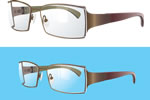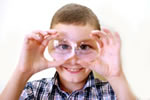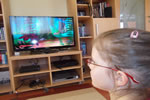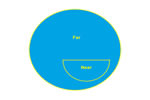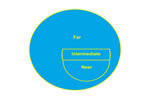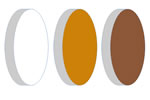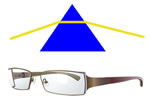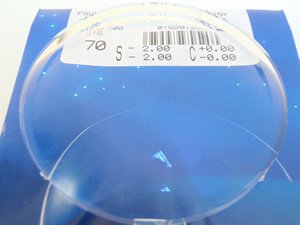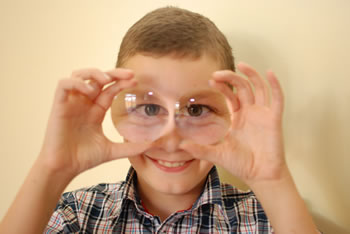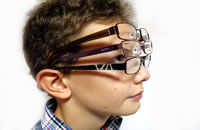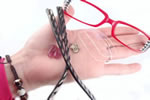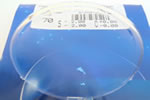Eyeglass Lenses That Fit Your Lifestyle and Frame - Step 3
The most important parts of your eyeglasses are the eyeglass lenses, the main purpose of them is to protect and correct your vision.
Without lenses, glasses are just a fashion accessory. You can read about lenses diopters, material, thickness and shape, coatings and brand to make an informed choice.
Next, see the characteristics of lenses for different activities, according to your color for best eyeglasses, chosen at Step 1:
Follow your glasses color or skip this section
Lenses for distance vision
The number of diopters
The lenses for distance vision are monofocal. It means that for activities like: driving, TV watching, sports, you’ll have one diopter lenses with the prescription you get.
Materials
For distance vision, you can use all available eyeglass lens materials. The most used lens material is the plastic.
If you are a sportsman, I suggest you polycarbonate or trivex lenses: light, thinner, highly resistant to impacts and scratches.
Very useful for activities that use lenses for distance vision are the...
Coatings
To improve the quality of eyeglass lenses, can require layers of protective materials (foils) in order to protect your eyes and the lenses. You can choose the next coatings for your eyeglass lenses as needed:
- Hardening: is a foil that will increase the lens resistance on scratching and breaking. It can be applied to lenses, in a single layer or multiple layers. Recommended for all activities, but mostly for sports, where the scratching and breaking are frequent.
- Anti-reflective coating: recommended for TV, outside in general and especially for drivers.
If spend much time outside, your lenses will focus more light into your eyes, even you've not worn sunglasses before, you might want lenses that protect your eyes from the sun. In this case, these are the mandatory coatings:
- Colored foils can be applied in various colors. It can vary in color intensity between 10% - 80%. They change the lens color and protects eyes from the sun.
- UV coating: this protection is for different wavelengths of UV. Is not visible and it do not change the properties of the eyeglass lenses.
- Transition lenses (photochromic lenses): for white lenses indoor and colored lenses outside
Lenses for intermediate vision
The number of diopters
For intermediate vision, you can use single vision lenses with one diopter, but for a more accurate computer vision especially, you have the option with degressive lenses. These contains the diopters for intermediary and close vision. It is a lens used for monitor and keyboard at the computer, an “office lens".
Let’s say you work at the office, and you have prescription only for close vision, the degressive lenses are right for you because they increase your view range from 12-16 inches (30-40 cm), which is the close vision glass view distance, to 3-6 foot (1-2 m), for computer and office.
Materials
In terms of the lens materials, you have more options from traditional to modern materials, but most likely will want plastic because of the price-quality ratio, with the following ...
Coatings
To protect your eyes against fatigue, working on computer, anti-reflective coating is a must and the unique computer lenses will help a lot.
Lenses for near vision
The number of diopters
The eyeglasses for reading or close work will have one diopter as prescribed.
Materials
No special needs in terms of lens materials for near vision eyeglasses, you can choose what best suits you as price and quality, but plastic is the most used material (lighter and hard to break).
It's good to have some protective coatings like ...
Coatings
- Hardening: is a foil that fits any lenses, to extend the lens resistance on scratching and breaking. Can be applied in a single layer or multiple layers
- Anti-reflective coating it is a good support when using tablets a lot
Lenses for multifocal vision
The number of diopters
You choose this color because you need lenses to see at more distances. Lenses will contain more diopters obviously, from close to distance vision.
Offers vary from:
- Bifocal eyeglasses - lenses with 2 diopters, dedicated to those who need glasses for far and near vision
- Trifocals - contains the far vision diopters in the upper part, the close vision diopters being present in the bottom as a square, which contains also, the intermediary diopters
- To the modern progressive lenses, which are most effective giving the highest clarity of vision at all distances.
Helpful Tips
For your progressive or bifocal glasses it's not a bad idea to have extra mono focal glasses. If an accident happens to your glasses, you’ll stay without a clear vision for both, distance and close.
Materials
These glasses you will wear all day, so it is important in terms of the eyeglass lens materials to choose a comfortable material, light and strong, with the right price for you. Then after, you have chosen, improve the quality of your lenses with...
Coatings
First, use the hardening foil to increase the lens resistance on scratching and breaking and anti-reflective coating good for any activity. Then depending on the activities you practice more often choose between:
- Colored foils, UV coating or photochromic lenses for sun protection
- Computer lenses if spend much time at the computer.
See this movie made in our store while polishing lenses, how the lens is shaping for a pair of new glasses ...
Was this video helpful? Follow Us
You can read more about matching your lenses with the chosen frame or...
Continue to Step 4 – Eyeglass Accessories
Quick Links - Eyeglass Lenses
Best eyeglass lenses for your frame
We talk about the aesthetic reason of choosing the right lenses for your frame.
For prescription lenses to fit the frame of your choice and look good, you have to see how they look after being polished, so you need to know about thickness and shape.
What is influencing the thickness and shape of the lens is:
The eyeglass lenses diopters
The only unchangeable aspect of lenses, where you don't have different options is the lenses diopters.
The diopter is determined by optometric consultation and contains the necessary correction for a clear vision. Opticians are bounded to respect your lenses prescription, no matter what glasses you will like.
Without entering in the details of your prescription have to know that depending on the diopters of the lens, they have a certain thickness.
Lens thickness
For example:
- The (+) diopters lens, which can be (+1. +1.50,+2 ...) also known as convex lens is thicker in the middle and thinner at the edge
- The (-) diopters lens, which can be ( -1, -2, -2.50 ...) also known as concave lens is thinner in the middle and thicker at the edge.
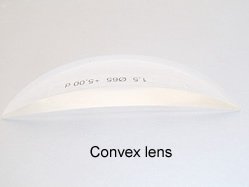
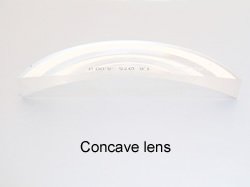
Apart from the two most commonly used types of lenses mentioned above, there are irregularly shaped lenses like:
- Cylindrical lens which has different thickness in different parts of the lens
- The lenses for prism eyeglasses which decreases in thickness from one end to another
Now that, you know about your lens thickness, you can fit them in the frame you have chosen. There are two possibilities:
- You choose a thick frame to cover the thick lenses, or if you want a rimless frame and lenses are thin, it’s ok
- The lens thickness is not covered, and you will receive an inaesthetic eyeglass, directly for this aesthetic reason, you can use the high index lens
How much the brand matters to eyeglass lenses
High quality lenses results after years of experience and constant upgrades of the manufacturing technologies.
Big companies are constantly developing innovations and technologies that improve the quality of lenses focusing on:
- durability
- vision clarity
- eye protection
- high comfort
For example, the resistance to breakage and scratching is superior in favor of leading brand companies.
I could see the differences between eyeglass lenses of different manufacturers over time in my job. Differences appeared after about one year of wearing. The same is with different coatings on the lenses.
Helpful Tips
Always choose, if you can, products of known companies in the field.
As you could see, matching of eyeglass lenses with the frame and your lifestyle is necessary to get the best eyeglasses. You have to consider several factors to get the maximum comfort and clear vision, in all conditions with your glasses.
Your next step – Choosing eyeglass accessories
Now that you have the eyeglass frame and the lenses, go ahead and accessorize your eyeglasses, so…
Was this information useful?
1. Like Perfect-Eyeglasses-Guide.com on Facebook.
2. Share this article with your friends:




